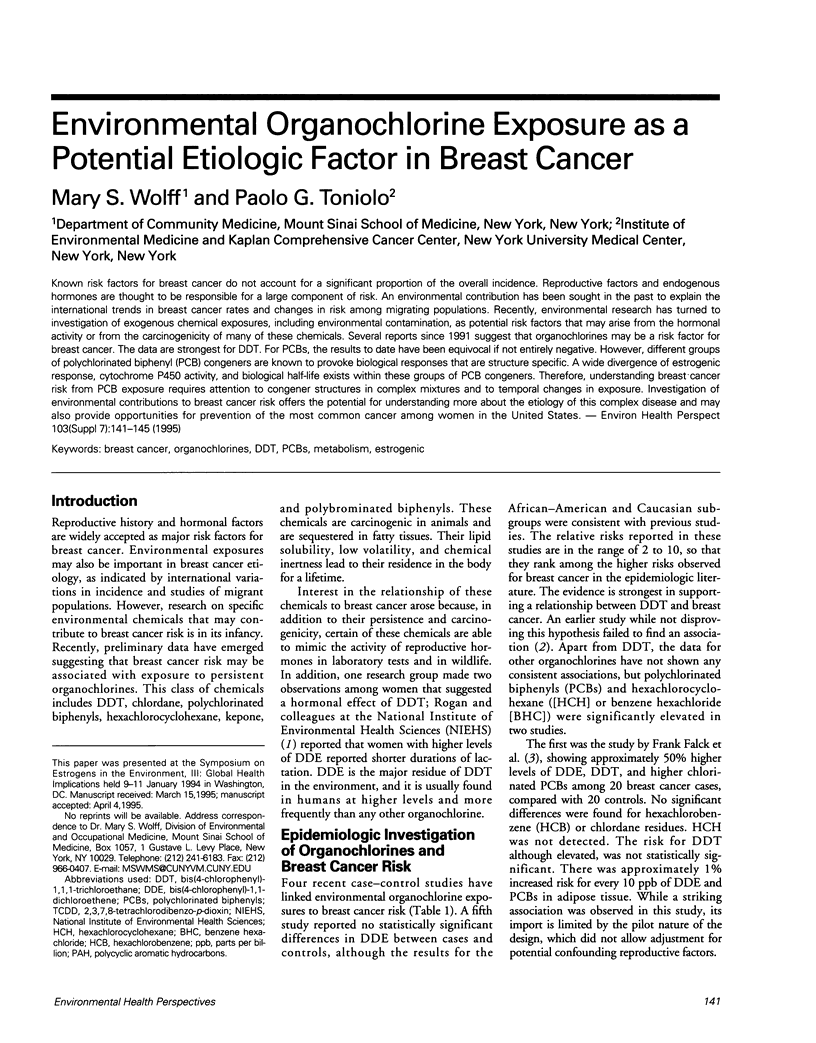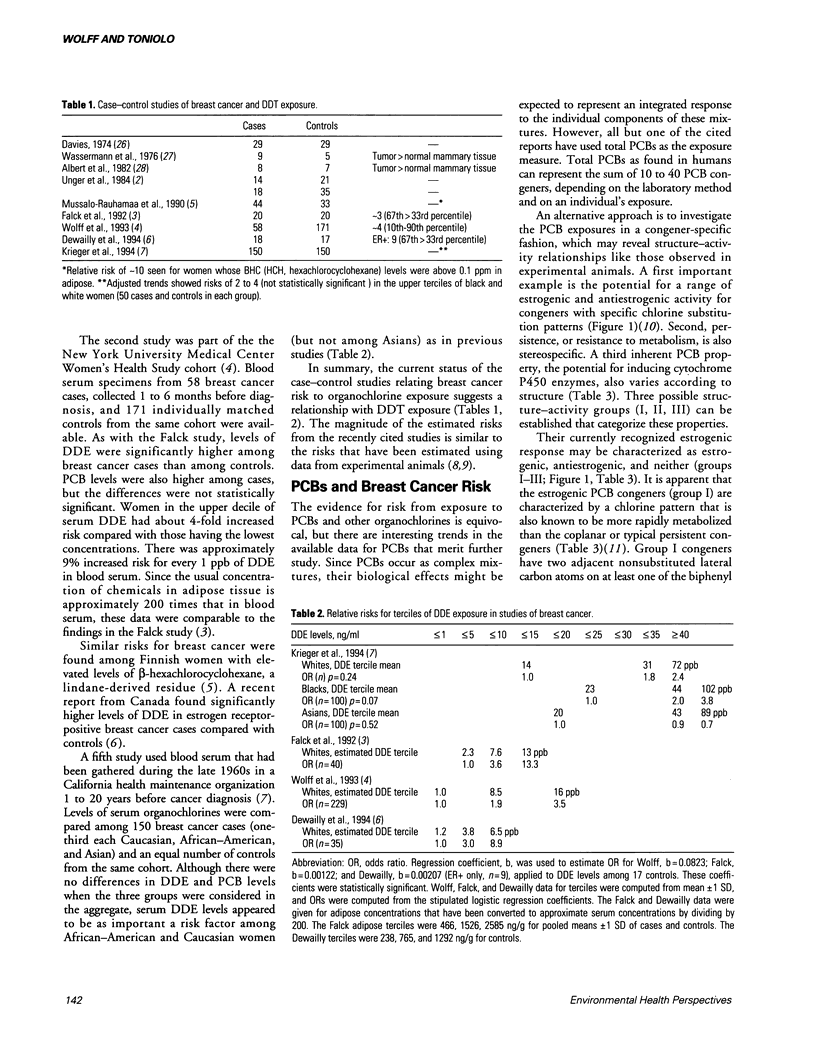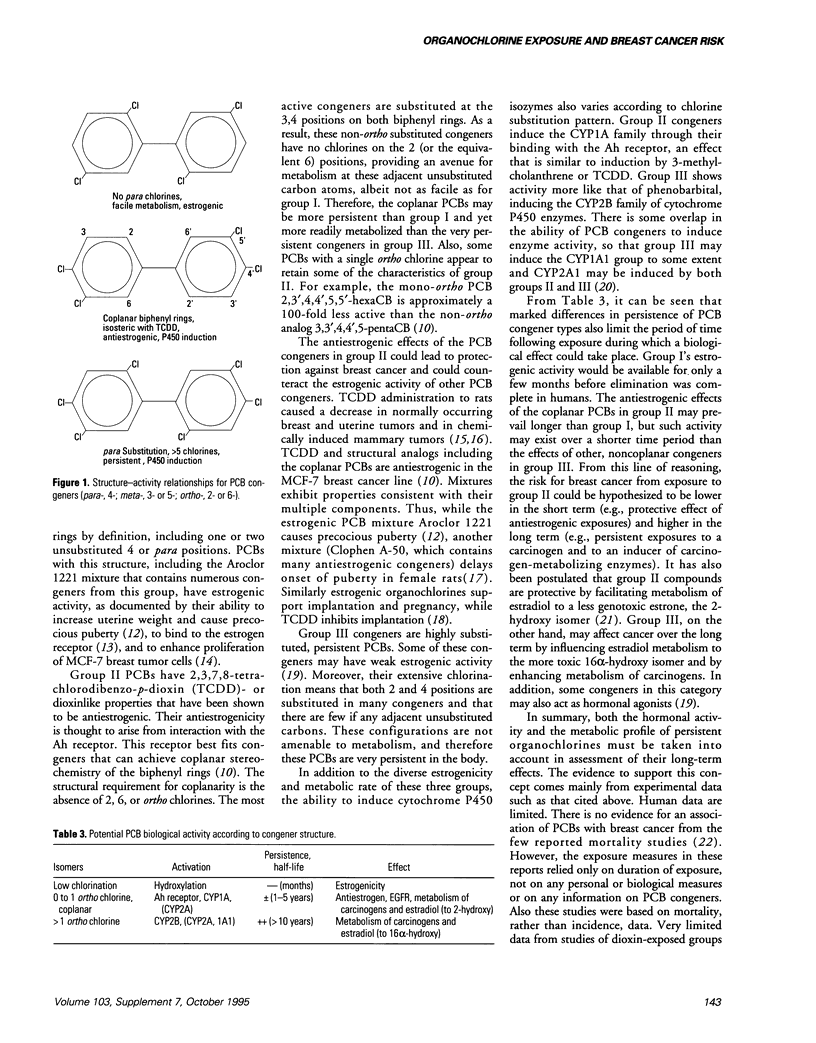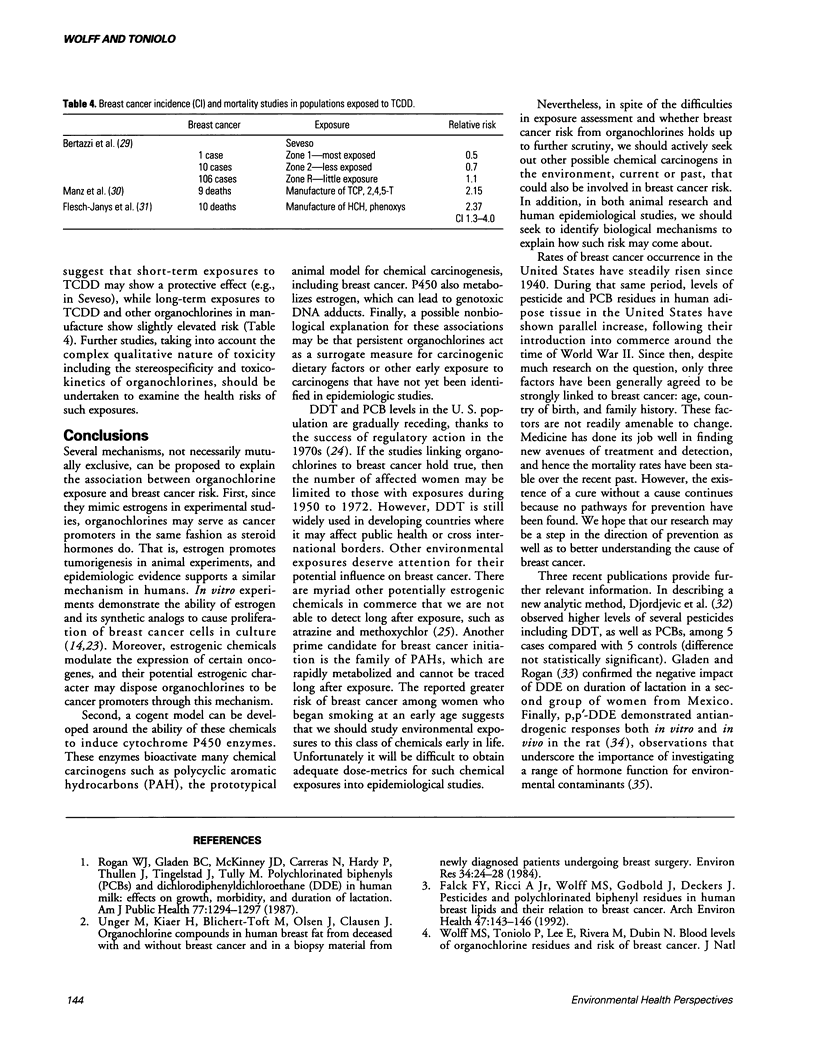Abstract
Known risk factors for breast cancer do not account for a significant proportion of the overall incidence. Reproductive factors and endogenous hormones are thought to be responsible for a large component of risk. An environmental contribution has been sought in the past to explain the international trends in breast cancer rates and changes in risk among migrating populations. Recently, environmental research has turned to investigation of exogenous chemical exposures, including environmental contamination, as potential risk factors that may arise from the hormonal activity or from the carcinogenicity of many of these chemicals. Several reports since 1991 suggest that organochlorines may be a risk factor for breast cancer. The data are strongest for DDT. For PCBs, the results to date have been equivocal if not entirely negative. However, different groups of polychlorinated biphenyl (PCB) congeners are known to provoke biological responses that are structure specific. A wide divergence of estrogenic response, cytochrome P450 activity, and biological half-life exists within these groups of PCB congeners. Therefore, understanding breast cancer risk from PCB exposure requires attention to congener structures in complex mixtures and to temporal changes in exposure. Investigation of environmental contributions to breast cancer risk offers the potential for understanding more about the etiology of this complex disease and may also provide opportunities for prevention of the most common cancer among women in the United States.
Full text
PDF




Selected References
These references are in PubMed. This may not be the complete list of references from this article.
- Bertazzi A., Pesatori A. C., Consonni D., Tironi A., Landi M. T., Zocchetti C. Cancer incidence in a population accidentally exposed to 2,3,7,8-tetrachlorodibenzo-para-dioxin. Epidemiology. 1993 Sep;4(5):398–406. doi: 10.1097/00001648-199309000-00004. [DOI] [PubMed] [Google Scholar]
- Colborn T., vom Saal F. S., Soto A. M. Developmental effects of endocrine-disrupting chemicals in wildlife and humans. Environ Health Perspect. 1993 Oct;101(5):378–384. doi: 10.1289/ehp.93101378. [DOI] [PMC free article] [PubMed] [Google Scholar]
- Davis D. L., Bradlow H. L., Wolff M., Woodruff T., Hoel D. G., Anton-Culver H. Medical hypothesis: xenoestrogens as preventable causes of breast cancer. Environ Health Perspect. 1993 Oct;101(5):372–377. doi: 10.1289/ehp.93101372. [DOI] [PMC free article] [PubMed] [Google Scholar]
- Dewailly E., Dodin S., Verreault R., Ayotte P., Sauvé L., Morin J., Brisson J. High organochlorine body burden in women with estrogen receptor-positive breast cancer. J Natl Cancer Inst. 1994 Feb 2;86(3):232–234. doi: 10.1093/jnci/86.3.232. [DOI] [PubMed] [Google Scholar]
- Djordjevic M. V., Hoffmann D., Fan J., Prokopczyk B., Citron M. L., Stellman S. D. Assessment of chlorinated pesticides and polychlorinated biphenyls in adipose breast tissue using a supercritical fluid extraction method. Carcinogenesis. 1994 Nov;15(11):2581–2585. doi: 10.1093/carcin/15.11.2581. [DOI] [PubMed] [Google Scholar]
- Falck F., Jr, Ricci A., Jr, Wolff M. S., Godbold J., Deckers P. Pesticides and polychlorinated biphenyl residues in human breast lipids and their relation to breast cancer. Arch Environ Health. 1992 Mar-Apr;47(2):143–146. [PubMed] [Google Scholar]
- Foran J. A., Cox M., Croxton D. Sport fish consumption advisories and projected cancer risks in the Great Lakes basin. Am J Public Health. 1989 Mar;79(3):322–325. doi: 10.2105/ajph.79.3.322. [DOI] [PMC free article] [PubMed] [Google Scholar]
- Gellert R. J. Uterotrophic activity of polychlorinated biphenyls (PCB) and induction of precocious reproductive aging in neonatally treated female rats. Environ Res. 1978 Jul;16(1-3):123–130. doi: 10.1016/0013-9351(78)90149-4. [DOI] [PubMed] [Google Scholar]
- Gladen B. C., Rogan W. J. DDE and shortened duration of lactation in a northern Mexican town. Am J Public Health. 1995 Apr;85(4):504–508. doi: 10.2105/ajph.85.4.504. [DOI] [PMC free article] [PubMed] [Google Scholar]
- Holcomb M., Safe S. Inhibition of 7,12-dimethylbenzanthracene-induced rat mammary tumor growth by 2,3,7,8-tetrachlorodibenzo-p-dioxin. Cancer Lett. 1994 Jul 15;82(1):43–47. doi: 10.1016/0304-3835(94)90144-9. [DOI] [PubMed] [Google Scholar]
- Jansen H. T., Cooke P. S., Porcelli J., Liu T. C., Hansen L. G. Estrogenic and antiestrogenic actions of PCBs in the female rat: in vitro and in vivo studies. Reprod Toxicol. 1993 May-Jun;7(3):237–248. doi: 10.1016/0890-6238(93)90230-5. [DOI] [PubMed] [Google Scholar]
- Johnson D. C., Sen M., Dey S. K. Differential effects of dichlorodiphenyltrichloroethane analogs, chlordecone, and 2,3,7,8-tetrachlorodibenzo-p-dioxin on establishment of pregnancy in the hypophysectomized rat. Proc Soc Exp Biol Med. 1992 Jan;199(1):42–48. doi: 10.3181/00379727-199-43326. [DOI] [PubMed] [Google Scholar]
- Kelce W. R., Stone C. R., Laws S. C., Gray L. E., Kemppainen J. A., Wilson E. M. Persistent DDT metabolite p,p'-DDE is a potent androgen receptor antagonist. Nature. 1995 Jun 15;375(6532):581–585. doi: 10.1038/375581a0. [DOI] [PubMed] [Google Scholar]
- Kociba R. J., Keyes D. G., Beyer J. E., Carreon R. M., Gehring P. J. Long-term toxicologic studies of 2,3,7,8-tetrachlorodibenzo-p-dioxin (TCDD) in laboratory animals. Ann N Y Acad Sci. 1979 May 31;320:397–404. doi: 10.1111/j.1749-6632.1979.tb56620.x. [DOI] [PubMed] [Google Scholar]
- Korach K. S., Sarver P., Chae K., McLachlan J. A., McKinney J. D. Estrogen receptor-binding activity of polychlorinated hydroxybiphenyls: conformationally restricted structural probes. Mol Pharmacol. 1988 Jan;33(1):120–126. [PubMed] [Google Scholar]
- Krieger N., Wolff M. S., Hiatt R. A., Rivera M., Vogelman J., Orentreich N. Breast cancer and serum organochlorines: a prospective study among white, black, and Asian women. J Natl Cancer Inst. 1994 Apr 20;86(8):589–599. doi: 10.1093/jnci/86.8.589. [DOI] [PubMed] [Google Scholar]
- Krishnan V., Safe S. Polychlorinated biphenyls (PCBs), dibenzo-p-dioxins (PCDDs), and dibenzofurans (PCDFs) as antiestrogens in MCF-7 human breast cancer cells: quantitative structure-activity relationships. Toxicol Appl Pharmacol. 1993 May;120(1):55–61. doi: 10.1006/taap.1993.1086. [DOI] [PubMed] [Google Scholar]
- Kutz F. W., Wood P. H., Bottimore D. P. Organochlorine pesticides and polychlorinated biphenyls in human adipose tissue. Rev Environ Contam Toxicol. 1991;120:1–82. doi: 10.1007/978-1-4612-3080-9_1. [DOI] [PubMed] [Google Scholar]
- Lundkvist U. Clinical and reproductive effects of Clophen A50 (PCB) administered during gestation on pregnant guinea pigs and their offspring. Toxicology. 1990 Apr 30;61(3):249–257. doi: 10.1016/0300-483x(90)90175-g. [DOI] [PubMed] [Google Scholar]
- Manz A., Berger J., Dwyer J. H., Flesch-Janys D., Nagel S., Waltsgott H. Cancer mortality among workers in chemical plant contaminated with dioxin. Lancet. 1991 Oct 19;338(8773):959–964. doi: 10.1016/0140-6736(91)91835-i. [DOI] [PubMed] [Google Scholar]
- McLachlan J. A. Functional toxicology: a new approach to detect biologically active xenobiotics. Environ Health Perspect. 1993 Oct;101(5):386–387. doi: 10.1289/ehp.93101386. [DOI] [PMC free article] [PubMed] [Google Scholar]
- Mussalo-Rauhamaa H., Häsänen E., Pyysalo H., Antervo K., Kauppila R., Pantzar P. Occurrence of beta-hexachlorocyclohexane in breast cancer patients. Cancer. 1990 Nov 15;66(10):2124–2128. doi: 10.1002/1097-0142(19901115)66:10<2124::aid-cncr2820661014>3.0.co;2-a. [DOI] [PubMed] [Google Scholar]
- Rogan W. J., Gladen B. C., McKinney J. D., Carreras N., Hardy P., Thullen J., Tingelstad J., Tully M. Polychlorinated biphenyls (PCBs) and dichlorodiphenyl dichloroethene (DDE) in human milk: effects on growth, morbidity, and duration of lactation. Am J Public Health. 1987 Oct;77(10):1294–1297. doi: 10.2105/ajph.77.10.1294. [DOI] [PMC free article] [PubMed] [Google Scholar]
- Safe S. H. Polychlorinated biphenyls (PCBs): environmental impact, biochemical and toxic responses, and implications for risk assessment. Crit Rev Toxicol. 1994;24(2):87–149. doi: 10.3109/10408449409049308. [DOI] [PubMed] [Google Scholar]
- Silberhorn E. M., Glauert H. P., Robertson L. W. Carcinogenicity of polyhalogenated biphenyls: PCBs and PBBs. Crit Rev Toxicol. 1990;20(6):440–496. doi: 10.3109/10408449009029331. [DOI] [PubMed] [Google Scholar]
- Soontornchat S, Li MH, Cooke PS, Hansen LG. Toxicokinetic and Toxicodynamic Influences on Endocrine Disruption by Polychlorinated Biphenyls. Environ Health Perspect. 1994 Jun;102(6-7):568–571. doi: 10.1289/ehp.94102568. [DOI] [PMC free article] [PubMed] [Google Scholar]
- Tiwari R. K., Guo L., Bradlow H. L., Telang N. T., Osborne M. P. Selective responsiveness of human breast cancer cells to indole-3-carbinol, a chemopreventive agent. J Natl Cancer Inst. 1994 Jan 19;86(2):126–131. doi: 10.1093/jnci/86.2.126. [DOI] [PubMed] [Google Scholar]
- Unger M., Kiaer H., Blichert-Toft M., Olsen J., Clausen J. Organochlorine compounds in human breast fat from deceased with and without breast cancer and in a biopsy material from newly diagnosed patients undergoing breast surgery. Environ Res. 1984 Jun;34(1):24–28. doi: 10.1016/0013-9351(84)90072-0. [DOI] [PubMed] [Google Scholar]
- Wassermann M., Nogueira D. P., Tomatis L., Mirra A. P., Shibata H., Arie G., Cucos S., Wassermann D. Organochlorine compounds in neoplastic and adjacent apparently normal breast tissue. Bull Environ Contam Toxicol. 1976 Apr;15(4):478–484. doi: 10.1007/BF01685076. [DOI] [PubMed] [Google Scholar]


